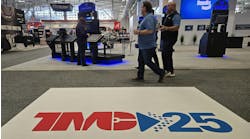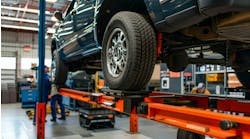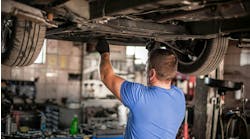Q: What are some reasons a shop may need a new lift?
Trevor Coleman: Lift repairs are over one-third of the cost of a new lift; buying new and having a new warranty would make more sense. Another reason is if your needs have changed, like the types of vehicles you repair. Maybe you have started to repair EV or HD. You should own lifts that service 90 percent or more of vehicles that come in your shop, allowing you to maximize your profit.
Sean Price: You may want to take advantage of the latest lift technology, like better arm restraints, greater arm extension and retraction to reach more OEM lifting points, or other advances that help boost technician productivity and safety.
Bob O’Gorman: Putting aside any business reasons associated with the decision to replace a car lift, and instead with a focus purely on employee and customer safety, it is important to understand that an annual lift inspection performed by an ALI-certified lift inspector can identify if a lift is no longer fit for service.
In addition to the mandated annual inspection, technicians and other employees must be empowered to take action if a lift is showing signs of malfunctioning. This boils down to an operator immediately stopping use of the lift and the employer scheduling an inspection to determine if maintenance or replacement is required.
Q: What additional equipment is needed to accompany lifts?
SP: Lift adapters! Having the right adapters lets you use a single two-post lift to service a wide range of vehicles. Screw pad lift assemblies, stacking adapters, slotted pinch-weld pucks or pads, cradle adapters, and more are all designed to help you reach more OEM-recommended lifting points for secure lifting.
Also consider rolling jacks for four-post lifts or a crossbeam adapter for mobile column lifts expands their versatility to let you do wheels- free work.
And lift tables save your back by using portable lifting tables to lift and lower heavy components like EV battery packs, engines, and other powertrain components.
Q: What training/safety precautions are necessary for technicians operating a lift?
TC: Technicians should receive hands-on training by their employer based on the type of lift they will be utilizing. They should also be given a copy of [ALI’s] Lifting it Right Guide and the daily maintenance schedule for their equipment. This will allow them to do a visual inspection daily to ensure their lift is operating properly.
They should also utilize the ALI training program. This program teaches the basics of lifting and comes with a short test the technician has to answer to pass. It is not lift-specific but covers the basics of lifting and the different types of lifts.
Q: What is the importance of having an ALI-certified lift?
SP: The significance is that you are trusting that lift with your life every time you walk under it to work. The only way to guarantee your lift meets industry safety and performance standards is to buy an ALI-certified lift. ALI is the only organization in North America with an accredited program to independently test and certify that a lift model meets safety and performance requirements and that the manufacturer meets quality control mandates. Sadly, some people seem to think all lifts are pretty much built the same. But ALI-certified lifts have been tested by experts from nationally recognized testing labs to verify the material strength and performance of every component on the lift, as well as to confirm it operates as designed and can lift its rated capacity without failure. Uncertified lifts are untested, unproven lifts.
In addition to safety, the other significant point is a practical one. There are plenty of uncertified lifts out there for sale. But if you install any of them in a commercial setting, you’re violating the International Building Code. So, if protecting your life isn’t reason enough to choose ALI-certified, how about protecting your livelihood? A lift that gets tagged out by an OSHA or building inspector for not being ALI-certified isn’t helping you make a living.
Q: What upkeep is needed for lifts?
TC: The manufacturer’s maintenance schedules should be followed. Most will call out daily, weekly, and monthly maintenance schedules — typically located in the installation manual. Most will call out:
- Visual inspections for broken or missing parts
- Making sure lifts are lubricated where needed
- Check for leaking hydraulics
- Check the torque of anchors
- Check to ensure that locks are functioning properly
- Check for frayed or damaged cables
Q: How often should a shop have their lift/s inspected? Who can perform these inspections?
BOG: Every lift should be inspected by a qualified lift inspector at least annually, more often if recommended by the lift manufacturer. In 2021, we introduced the Check360 Certified Lift Inspection. This is a comprehensive lift inspection process that meets all the requirements outlined in ANSI/ALI ALOIM: 2020, including a comprehensive examination of the lift structure, electrical and mechanical components, as well as a review of training logs, operating instructions and safety materials. Only ALI-certified lift inspectors can perform Check360 lift inspections. At the conclusion of a Check360 lift inspection, the lift inspector will provide a thorough report of the results, including any concerns and recommendations. Those lifts that pass inspection will receive an exclusive Check360 Certified Lift Inspection label.
Q: How does servicing EVs affect the lift a shop might buy?
SP: Lifting electric vehicles presents unique challenges because EVs tend to be heavier and have harder-to-reach lift points than traditional vehicles. Most EVs are designed with their high-volt age batteries under the vehicle. The battery packs are large – taking up most of the undercarriage – and heavy. As a result, the OEM-recommended lifting points are often on the far edges of the vehicle frame. To safely lift an EV, you’ll need a vehicle lift with sufficient rated capacity and the capability to engage with the lifting points.




